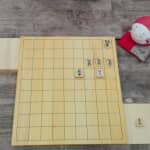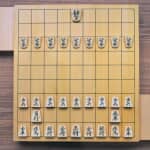Shogi 18 May 2017
Shogi Rules – How to Play Shogi – : Step 2-5 Address of Shogi Piece
Explore art of Shogi. A professional Shogi player invites you to the world of Shogi along with traditional Japanese culture.
*Please note that the Kanji numbers in pictures are spelled in English in the text.
The following Shogi boards have a face with files (vertical rows) numbered 1 through 9 from right to left, and ranks (horizontal rows) designated with Kanji characters, “一” (One) to “九” (Nine), from top to bottom. On the other hand, in the text, each Kanji character is replaced with an alphabet, from “a” to “i” : “一” with “a”, “二” with “b”, … and “九” with ”i”.
Like your house, Shogi board has an address. When it comes to piece moves, this address becomes a key element. Moves described with that address is called “Fugou”. You can capture the whole picture of piece-positions with Fugou without seeing pieces placed on a board.
“Kifu” is a game record of all piece moves throughout the game in the correct order. Kifu is recorded using Fugou, which corresponds to a notation for chess. It shows that by who, when and what piece moves were made during a game. Mastering how to read Kifu, you can replicate all moves done by professional Shogi players. This action is named “Kifu-narabe”.
Now, let’s discuss details about Fugou. (Note: the Fugou described in this article is written in English and slightly different from our Japanese version.) A regular Shogi board has 9 vertical rows and 9 horizontal rows. Vertical rows are called files, and ranks for horizontal rows. Files are described in a number from 1 to 9, and Rows are with alphabetical small letters from “a” to “i”.
When you write Shogi Fugou in English, it goes as follows:
“Abbreviation of piece-name in English” + “Number for File in Arabic numeral” + “Number for Rank in alphabet”. Examples are shown below.


As you see in #3 above, when a piece is promoted in opponent’s camp, “+” is added at the end of Fugou:
“Number for File” + “Number for Rank” + “Name for the piece” + “+”.
Japanese notation style has several ways to signify “promotion”, incidentally.
If you would like to learn Fugou in Japanese, as the first step, you need to become familiar with Japanese/Chinese characters used in Fugou.
Eleven characters used to indicate names of pieces:
王 for King, 角 for Bishop, 飛 for Rook, 金 for Gold, 銀 for Silver, 桂 for Knight, 香 for Lance, 歩 for Pawn, 馬 for Horse, 龍(竜) for Dragon, and 成 for promotion.
Others for numbers set for Rank:
一 for one, 二 for two, 三 for three, 四 for four, 五 for five, 六 for six, 七 for seven, 八 for eight, and 九 for nine.
It would be wonderful if you have a passion for learning Japanese Fugou system in Japanese.
After the lesson
The below is a comment from a mother whose daughters have just learned Fugou in Japanese:
My daughters were already able to read Chinese letters on pieces, so they didn’t have any difficulties reading Fugou. They found it interesting to find out a piece-location with information of Fugou. They said it was just like working out a puzzle. At the same time, it seems that their writing skills are not as good as their reading ones. I noticed they had vague knowledge about a stroke order for a certain character that they had learned at school. Our family struggled with reviewing correct stroke orders.
It looks like my daughters play Shogi better now with good knowledge of Fugou.



